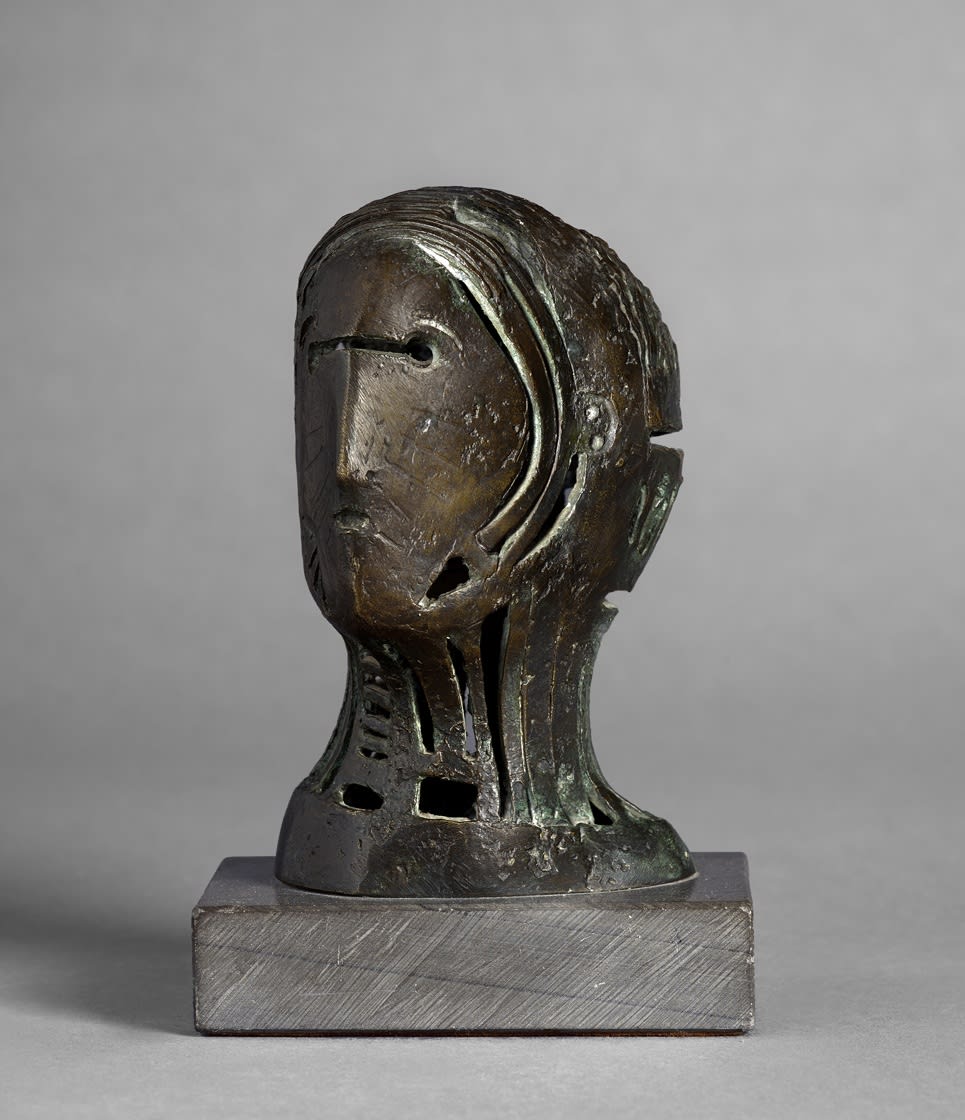Henry Moore 1898-1986
14.5 x 8.5 x 5.5 cm
Maquette for Openwork Head No.2, 1950 is the preparatory work for the 15½ inch bronze Openwork Head No.2, 1950, which resides in the permanent collection of The Hepworth, Wakefield. The Openwork Heads relate closely to another group, Moore’s ‘Helmet Heads’, which were first conceived in a series of drawings in 1939 and which he reimagined extensively in sculptural form in 1950. The smaller ‘Openwork’ series is believed to comprise of only six works. This little maquette, made in preparation for the larger version, was not editioned and as such is a unique and particularly rare object.
Amongst the artist’s most experimental sculptures, the Openworks are hollow bronze forms with numerous openings, which, as David Sylvester notes, ‘enable the spectator to perceive the precise volume of the head by permitting him to see through it to the other side.’ 1 The openings contrast with the density of the solid parts and as such recall Moore’s stringed sculptures from the 1930s. Moving around the work animates these slivers of light, creating a dramatic interplay between the external shell and the internal void.
Here the neck and back of the head are delineated by the intricate latticing of the bronze, producing a criss-cross of small square and rectangular punctures. Long, sweeping openings and incisions, which frame the face, give the impression that the sculpture has been lifted from one of Moore’s sketchbooks, where contour lines are used to convey three-dimensional form. According to David Sylvester, the ‘cage-like’ inspiration for this head came directly from a Benin bronze of a tiger mauling a man that the artist had acquired in 1947.
To achieve such a detailed form, Moore modelled his maquette in wax, casting it himself in a foundry set up in his back garden in Perry Green, as he remembers:
‘I laid my strips of wax in the pattern that they are in the finished object, then this was covered with a further layer of the mixture of plaster and ground up pottery and the whole put into a kiln so that the wax melts out and leaves a space where it was, that is, between the core and the outside plaster. This space is filled with molten bronze so that you get an exact replica of where the wax was.’ 2
The artist’s decision to cast these forms himself was ignited by a desire in the 1950s to re-engage directly with the medium, through the whole casting process. Throughout his career Moore commissioned professional foundries to cast from his models and so the fact that this sculpture is the product of a process entirely carried out by the artist makes it all the more special. The artist had first tried his hand at lost-wax casting in his kitchen in Parkhill Road, Hampstead between 1929-31, using the rudimentary means of lead and a saucepan on a primus stove. This experiment was carried out by Moore in order to better understand the processes of metal casting, the structural properties of the material and its limits.
Moore favoured working in wax as it allowed him to achieve ‘forms much thinner and more open than ever you could have done direct in plaster.’ 3 Maquettes were essential to his way of working, enabling him to test a form in three dimensions. Their scale meant they could be held in the sculptor’s hand and examined from every point of view. The present maquette is extremely similar to the larger bronze, suggesting that Moore was very pleased with its outcome. The form of Maquette for Openwork Head No.2 relates directly to the lost wax casting process by which it was made. The mottled, pitted texture of the sculpture’s surface is indicative of the way Moore applied the investment to the model from which the bronze was cast. Indeed, when viewing Maquette for Openwork Head No.2 one gets a real, vivid sense of the artist’s hands at work as he carefully modelled the form.
Maquette for Openwork Head No.2, 1950 has a notable provenance. The sculpture was once in the collection of Robert von Hirsch, a German-Jewish industrialist who later emigrated to Switzerland. His extraordinary art collection included not only modern art but also Medieval antiquities, Old Master paintings, drawings, miniatures and Venetian glass. After the death of his wife in 1965, von Hirsch re-evaluated the future of his collection, choosing to gift certain works to relatives, friends and museums. The present work was inherited by von Hirsch’s great-niece, who, after moving to Australia, offered it to Portsmouth Art Gallery on long-term loan.
1 Sculpture and Drawings by Henry Moore, The Arts Council of Great Britain, 1951
2 Henry Moore, quoted in a letter to Helen Knapp, director of Wakefield City Art Gallery, 3 June 1952
3 Henry Moore, quoted in Henry Moore on Sculpture, Philip James (ed.), Macdonald, London, 1966, p137 & p139
Provenance
The artist
Mrs Louise Baker, Greenwich, Connecticut
Robert von Hirsch Collection
Nicola Pitt (Great Niece of Hirsch)
Thence by descent to 2015
Exhibitions
New York, Henry Moore, Buchholz Gallery, 6 March- 31 March 1951, cat no.32
Portsmouth Art Gallery, from 1978 on longterm loan
Literature
Alan Bowness, Henry Moore: Sclupture and Drawings 1949-1954, Volume 2, 2nd Edition, Percy Lund Humpries LTD, London, 1965, cat no.289, illus bw, p xxv
Ionel Jianou, Henry Moore, Arted, Paris, 1968, cat no. 271, not illus, p 76
Sotheby Parke Bernet, The Robert Von Hirsch Collection: The Collector, his house and his bequests, Volume 5, Sotheby's, June 1979, illus bw, p 13 as 'Head'
David Sylvester (ed) and Herbert Read, Henry Moore: Complete Sculpture, 1949-54, Vol II, London, 1986, no.288, illus p31
Join our mailing list
* denotes required fields
We will process the personal data you have supplied to communicate with you in accordance with our Privacy Policy. You can unsubscribe or change your preferences at any time by clicking the link in our emails.
